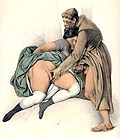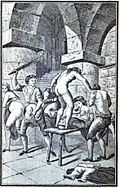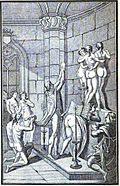- Convent pornography
-
Mr. Abbott Bitt at Convent, a pornographic film circa 1925

Convent pornography, convent erotica, friar erotica, priest erotica, monk erotica, or clergy erotica includes paintings, sculpture, photographs, dramatic arts, music and writings that show scenes of erotic or sexual nature involving clergy.
Contents
In Europe
In France
During the Enlightenment, many of the French free-thinkers began to exploit pornography as a medium of social criticism and satire. Libertine pornography was a subversive social commentary and often targeted the Catholic Church and general attitudes of sexual repression. The market for the mass-produced, inexpensive pamphlets soon became the bourgeoisie, making the upper class worry, as in England, that the morals of the lower class and weak-minded would be corrupted since women, slaves and the uneducated were seen as especially vulnerable during that time. The stories and illustrations (sold in the galleries of the Palais Royal, along with the services of prostitutes) were often anti-clerical and full of misbehaving priests, monks and nuns, a tradition that in French pornography continued into the 20th century. In the period leading up to the French Revolution, pornography was also used as political commentary; Marie Antoinette was often targeted with fantasies involving orgies, lesbian activities and the paternity of her children, and rumours circulated about the supposed sexual inadequacies of Louis XVI.[1][2] During and after the Revolution, the famous works of the Marquis de Sade were printed. They were often accompanied by illustrations and served as political commentary for their author.[3]
In South-east Asia
In the Philippines
Filipino historian Ambeth R. Ocampo described that during 19th-century Philippines the sexually attractive female body parts of the time were the "bare arms, a good neck or nape" and "tiny rosy feet". This is exemplified by Ocampo's chosen passages from Soledad Lacson-Locsin's unabridged English-language translation of the 25th Chapter of Jose Rizal's Spanish-language novel, the Noli Me Tangere:[4]
- "At last, Maria Clara emerged from the bath accompanied by her friends, fresh as a rose opening its petals with the first dew, covered with sparks of fire from the early morning sun. Her first smile was for Crisostomo (Ibarra), and the first cloud on her brow for Padre Salvi..." (Padre Salvi, although a priest, is an admirer of Maria Clara.) "Their legs were up to the knees, the wide folds of their bathing skirts outlining the gracious curves of their thighs. Their hair hung loose and their arms were bare. They wore striped gay-colored blouses... Pale and motionless, the religious Actaeon (i.e. Padre Salvi, who was hiding in the bushes, acting as a voyeur) watched this chaste Diana (i.e. Maria Clara): his sunken eyes glistening at the sight of her beautifully molded white arms, the graceful neck ending in a suggestion of a bosom. The diminutive rosy feet playing in the water aroused strange sensations and feelings in his impoverished, starved being and made him dream of new visions in his fevered mind."[4]
In My Sad Republic, Eric Gamalinda incorporated the genre of erotica such as what Angela Stuart-Santiago described as a "dash of friar erotica" (also known as "priest erotica") witnessed during the diminishing decades of the rule of the Spanish friars in the Philippines. Gamalinda described the love scene between a Spanish parish priest nicknamed Padre Batchoy and a native lass as if the friar was inserting a sacred host into the lips of a native girl's sex organ. There was another love scene – during a secret rendezvous between the novel's hero Magbuela and his beloved De Urquiza – wherein (according to Stuart-Santiago) De Urquiza did a "strange thing", lifting her a head a little to give Magbuela a prolonged bite on the hard and firm muscle located above Magbuela's collarbone, as if De Urquiza wanted to remain forever connected to Magbuela's body.[5]
In Australia
A novel that involves a love story or romance between a priest (Father Ralph de Bricassart) and a lay woman (Meghann "Meggie" Cleary) is The Thorn Birds, a 1977 best-selling novel by Colleen McCullough, an Australian author, which was adapted as a television mini-series in 1983.
Novel
In the novel, before Father Ralph’s departure, Meggie confesses her love for him; after a birthday party, Ralph finds her crying in the family cemetery and they share a passionate kiss, but Ralph refuses her because of his duties as a priest and begs Meggie to find someone to love and marry. Three years later, a new ranch worker named Luke O'Neill begins to court Maggie. Although his motives are more mercenary than romantic, she marries him because he looks a little bit like Ralph, but mainly because he is not Catholic and wants little to do with religion-her own way of getting back at Ralph. She soon realises her mistake. After a brief honeymoon, Luke, a skinflint who regards women as sex objects and prefers the company of men, finds Meggie a live-in job with a kindly couple, the Muellers, and leaves to join a gang of itinerant sugarcane cutters in North Queensland. Before he leaves, he appropriates all Meggie's savings and arranges to have her wages paid directly to him. He tells her he's saving money to buy a homestead; however, he quickly becomes obsessed with the competitive toil of cane-cutting and has no real intention of giving it up. Hoping to change Luke's ambition and settle him down, Meggie deliberately thwarts his usual contraception and bears Luke a red-haired daughter, Justine. The new baby, however, makes little impression on Luke.
Father Ralph visits Meggie during her difficult labour; he has come to say goodbye, as he is leaving Australia for Rome. He sees Meggie's unhappiness for himself, and pities her. Justine proves to be a fractious baby, so the Muellers send Meggie to an isolated island resort for a rest. Father Ralph returns to Australia, learns of Meggie's whereabouts from Anne Mueller, and joins her for several days. There, at last, the lovers consummate their passion, and Ralph realises that despite his ambition to be the perfect priest, his desire for Meggie makes him a man like other men. Father Ralph returns to the Church, and Meggie, pregnant with Ralph's child, decides to separate from Luke. She tells Luke what she really thinks of him, and returns to Drogheda, leaving him to his cane-cutting. Back home, she gives birth to a beautiful boy whom she names Dane. Fee, who has had experience in such matters, notices Dane's resemblance to Ralph as soon as he is born. The relationship between Meggie and Fee takes a turn for the better. Justine grows into an independent, keenly intelligent girl who loves her brother dearly; however, she has little use for anyone else, and calmly rebuffs Meggie's overtures of motherly affection.
Television
In the television mini-series, Ralph is advised by Archbishop Vittorio that he must face his temptations or he will always be controlled by them. Father Ralph learns of Meggie's whereabouts from Anne Mueller, and joins her for several days on Matlock Island. There, finally, the lovers consummate their passion, and Ralph realizes that despite his ambition to be the perfect priest, his desire for Meggie makes him a man like other men. Ralph loves Meggie, even more than God now, but still returns to the Church again choosing his own ambitions over Meggie. A short time later Meggie realizes that she has become pregnant with Ralph's child. The next chance she gets she tells Luke what she really thinks of him and leaves Queensland to return to Drogheda.
See also
References
- ^ Beck, Marianna (December, 2003). "The Roots of Western Pornography: the French Enlightenment takes on sex". Libido, the Journal of Sex and Sensibility. Libido Inc. http://www.libidomag.com/nakedbrunch/archive/europorn02.html. Retrieved 2006-08-22.
- ^ Beck, Marianna (February, 2003). "The Roots of Western Pornography: the French Revolution and the spread of politically-motivated pornography". Libido, the Journal of Sex and Sensibility. Libido Inc. http://www.libidomag.com/nakedbrunch/archive/europorn04.html. Retrieved 2006-08-22.
- ^ Beck, Marianna (March, 2003). "The Roots of Western Pornography: the Marquis de Sade's twisted parody of life". Libido, the Journal of Sex and Sensibility. Libido Inc. http://www.libidomag.com/nakedbrunch/archive/europorn05.html. Retrieved 2006-08-22.
- ^ a b Ocampo, Ambeth R. Fan Language, Looking Back, news.google.com
- ^ Stuart-Santiago, Angela. "Love, sex, and revolution in a 'landscape of despair', My Sad Republic by Eric Gamalinda, Centennial Literary Prize 1998, Best English Novel, U.P. Press, 2000". http://www.stuartxchange.org/BookReview3.html. Retrieved 3 July 2011.
Categories:
Wikimedia Foundation. 2010.





